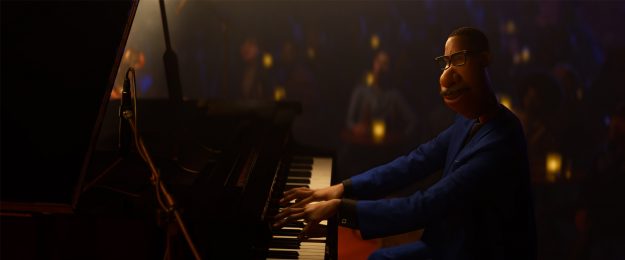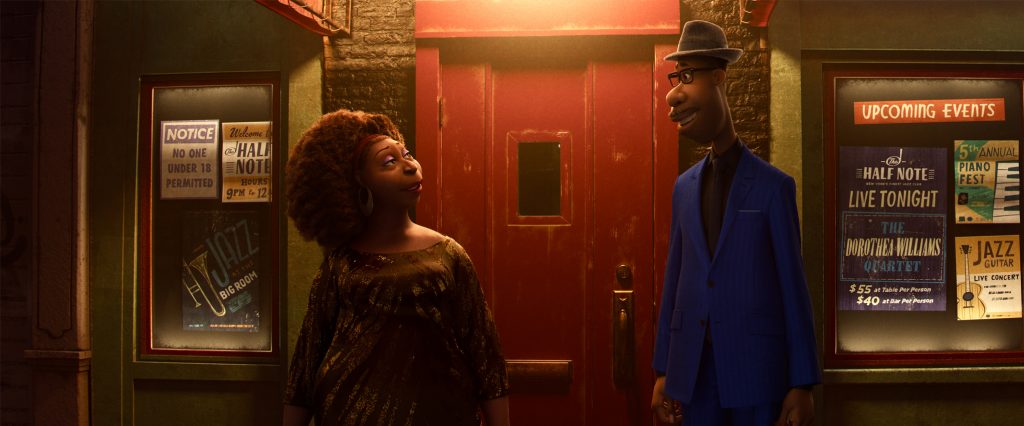In the final segment of Disney-Pixar’s animated film Soul, the character of jazz saxophonist Dorothea Williams (voiced by Angela Bassett) shares a lesson about goals. When her new and slightly disillusioned star pianist Joe Gardner (voiced by Jamie Foxx) remarks that he thought he would “feel different” after finally getting his big break, she says:
I heard this story about a fish. He swims up to this older fish and says, “I’m trying to find this thing they call the ocean.”
“The ocean?” says the older fish. “That’s what you’re in right now.”
“This?” says the young fish. “This is water. What I want is the ocean.”
Joe’s confusion at his anti-climactic breakthrough follows a bewildering existential odyssey. At the start of Soul, he unexpectedly dies—right after landing a gig with the great Dorothea. As a disembodied soul, he desperately navigates the trippy dimensions of the Great Beyond, the Great Before, and returns to life on earth just in time to perform his set that evening. But after all the drama, and after all the years of dreaming and practicing and waiting, Joe doesn’t experience a euphoric sense of accomplishment. In fact, it all feels pretty normal. As if he had been swimming in the waters of the ocean the entire time.
While Soul doesn’t explicitly mention (or endorse) Buddhist ideas of rebirth or pure lands, this pivotal scene about the fish in the ocean illustrates the paradox of Buddhist awakening.
The (unenlightened) young fish is like a new practitioner who seeks an ideal peak experience and thus clings to a self-constructed fantasy of what that experience might be. The wise old fish, however, has realized that such figments exist only in one’s own mind, and that enlightenment refers to nothing other than what is right here, right now, in the very quotidian waters of our lives—for as Dorothea says, “We come back tomorrow night and do it all again.” The wise fish has let go of even the desire for spiritual accomplishment and has therefore ironically attained it.
In the next scene, Joe realizes this insight for himself as he improvises a piece inspired by the concrete particulars of the day: a spool of thread, a lollipop, a pizza crust, and a maple tree’s helicopter-seed pod. His emotional connection to the simple suchness of these things generates gratitude for all the interconnected people and places in his life. It also compels him to the ultimate act of compassion in order to help save his friend, Lost Soul No. 22 (voiced by Tina Fey), from the dry ocean expanse of negative self-talk and low self-esteem.

The basic lessons of Buddhism are all here: pre-enlightened striving, post-enlightened realization that the path itself was the destination all along, a profound grasp of suchness, gratitude, compassion, and bodhisattva-like selflessness. For a children’s movie, these waters run pretty deep.
Don’t let the colorful animation fool you—venturing out into these deep waters is not for the faint of heart. Pixar’s latest may be different in tone and intent, but its oceanic allegory is not unlike other great fishermen’s tales such as The Old Man and the Sea. In Hemingway’s 1952 novella, Santiago dreams of capturing a prize marlin, but once he gets it, his accomplishment is utterly emptied out by a feeding frenzy of sharks. He returns to the other shore with only the skeletal traces of his great struggle, so there is nothing triumphant in his return from the deep waters. His only real ability is to help Manolin, the young apprentice-fisherman, along in his training.
Hemingway’s narrative mirrors the message that, from a post-enlightenment perspective, there is nothing particularly special about awakening, yet one must begin by intentionally setting out and setting sail for it anyway. Fishing for enlightenment ultimately means letting go of the prize, and this in turn means intimately and joyfully reengaging with the everyday as a result. As Zen master Dogen expressed it, “To study the self is to forget the self; to forget the self is to be confirmed by all dharmas.”
This is the same paradox of “Catching a Catfish with a Gourd,” a visual koan by the famous 15th-century Japanese Zen artist Josetsu. (That’s right, it’s another story about fish.) In the lower register of this hanging scroll, a catfish swims in the waters of a meandering river while a wizened old sage stands by the riverbank holding out a gourd, which symbolizes emptiness. Like all koans, the message here at first appears hazy but gradually comes into focus: by definition, one cannot obtain any one thing (like a catfish) when realizing the absolute emptiness of everything (symbolized by the gourd). How could you hold onto the utter essence-lessness of all compounded transients? This slippery paradox does not stop 31 Zen masters from inscribing their capping verse commentaries in the upper register of the scroll, joking that the slippery fish could be caught by greasing the gourd too, or venturing that it would make a delicious meal of catfish soup and rice. This latter comment riffs on the familiar Zen maxim that cautions against reifying even the image of enlightenment itself: “When you see the buddha, kill him! When you see the patriarch, kill him!” These Zen masters are essentially suggesting, by extension, that “When you see the catfish, cook him!”
All of this reminds me too of an old educational film called Buddhism: The Land of the Disappearing Buddha, which was part of The Long Search, a 1977 BBC documentary television series about world religions. British director Ronald Eyre’s cheesy ties and long sideburns have not aged well, but his interview with the abbot of a temple at the Daitokuji Zen temple complex in Kyoto is timeless. Rev. Kobori Nanrei says, “There is Buddha for those who do not know what he is really. There is no Buddha for those who know what he is really.” That is, Buddha exists for those who still need an ideal image to aspire to in order to get enlightened, but he doesn’t exist for those who no longer need such a mental prop. This is why in the famous Ten Ox-herding pictures of Zen, the bull initially represents the enlightened mind that the boy-novice must discipline in meditation, but eventually the buddha-bull-mind disappears entirely from view, for the boy realizes that he and the bull were always already non-distinct from the start, and that he was searching for something that was never lost to begin with.
The ox, the marlin, the catfish, the boy—they all ultimately disappear when the adept realizes that they were helpful but now obsolete tools to awakening. Sometimes, “the one that got away” is the one that truly makes the master.
But it is the post-experiential engagement with the everyday suchness of things that I find most compelling in all these fishermen’s tales. What do you do when you’re back on land? How do you act after you’ve been in the belly of the whale? What do you do with the prajnaparamita wisdom that you’ve obtained in the sea dragon’s palace at the bottom of the sea? For me, the litmus tests of any enlightened being in any religious tradition is humor and help: the ability to laugh at oneself and the world, and to seek out new ways to help generate joy in all the improbable and miraculous permutations that make up the mundane. Giving (dana) is key, but so too is teaching. As the saying goes, if you give a man a fish, you feed him for a day. But teach a man to fish, and you feed him for a lifetime.
Thank you for subscribing to Tricycle! As a nonprofit, we depend on readers like you to keep Buddhist teachings and practices widely available.
